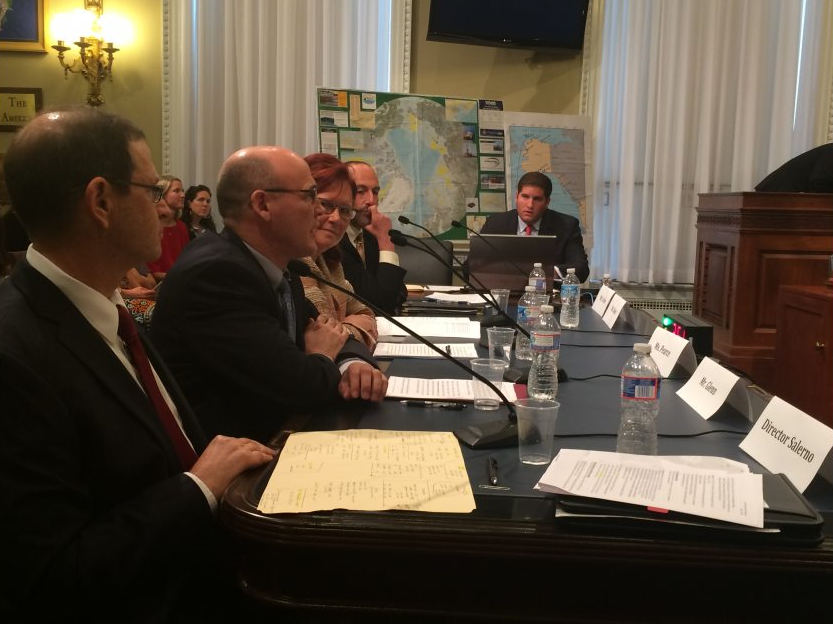Let locals decide fate of Arctic drilling says U.S. politician

WASHINGTON — What happens in the Arctic is the Arctic’s business, Rep. Don Young told members of a House subcommittee on Tuesday.
“He lives there,” Young said, referring to Richard Glenn, executive vice president of the Arctic Slope Regional Corp., who was in Washington, D.C., to testify before Congress about issues related to oil drilling in the Arctic. “He doesn’t live in California or Virginia or any other place. He lives there and understands this. And they are supporting this activity.”
When non-Alaskans say, “’Save the Arctic, preserve the Arctic, we can’t move forward,’ it’s very frustrating to hear that,” Young said.
Tuesday’s hearing of the House Subcommittee on Energy and Mineral Resources gave voice to ongoing disagreement over proposed regulations governing offshore drilling in the Beaufort and Chukchi seas: Are the standards too prescriptive, barring evolving and advancing new technologies? Is there any safe offshore drilling in the Arctic, or are the difficulties of cleaning up a spill too great?
“Frankly, I believe the administration is probably doing too much, too fast when it comes to oil drilling in the Arctic,” said the subcommittee’s ranking member, Rep. Alan Lowenthal, D-Calif. He pointed to oil development in the National Petroleum Reserve-Alaska, the Obama administration’s defense of offshore drilling leases in court, plans for new lease sales and the decision to allow Shell to move forward with new drilling attempts this summer.
“I think that’s a mistake,” Lowenthal said. “The Arctic is special. It’s remote. It has unique cultures and ecosystems.” And the impacts of climate change make the region even more sensitive, he said. Permafrost is melting and releasing carbon dioxide.
“This is a global warming death spiral,” Lowenthal said. “Drilling for more oil in the Arctic just makes this vicious cycle worse.”
‘Pictures of Eskimos that lived 100 years ago’
Glenn rejected the idea of ending Arctic drilling in the name of reducing carbon dioxide emissions.
“We know that planes will still fly, trains will still roll, and oil and gas development will continue, whether or not the Arctic is developed,” he said. “We live there. Regarding environmental risk, no one has more at stake than we do.”
The decision to support offshore drilling didn’t come easy to villagers in the Arctic, Glenn told lawmakers. Debate was carried on at “dinner tables at home” and in boardrooms and churches, “and it took a lot of research and partnering before we convinced ourselves that the safety measures can be in place.” The Arctic villages “have real-world needs like landfills and power plants and roads and schools. And our communities depend on those as much as we depend on the environment. So we came to the sobering realization that we depend on continued development, regardless of its source, for the survival of our villages.
Public perception of Alaska Natives based on “pictures of Eskimos that lived 100 years ago” are not accurate, Young said. “We have a need for education and health” care. “Some from other states don’t understand. They haven’t been there.” The decision about drilling is “their decision, only theirs, and not ours,” he said.
“Alaska needs the development, America needs the development, the federal government needs to make it happen,” said subcommittee Chairman Doug Lamborn, R-Colo., who questioned whether the federal government supports drilling as much as it should.
Industry, local residents, environmental groups and the federal government are sparring over the details of regulations proposed in February to govern Arctic offshore drilling. The oil industry says they are too prescriptive, shackling companies to costly technologies rather than dictating an outcome and allowing for innovation.
The Arctic “is not like other areas … where we have offshore drilling operations, where conditions and infrastructure can support nearly year-round operations,” said Brian Salerno, director of the Bureau of Safety and Environmental Enforcement at the Interior Department.
Salerno said Interior is also focused on the Native communities’ reliance on subsistence hunting and concerns he heard in Barrow in March. Support for drilling and for the new rule is mixed in the villages and the “industry will be operating in an environment where there is very little tolerance for error,” Salerno told the committee.
Glenn argued that the “national debate unnecessarily frames Arctic resource development in an either/or argument — preserve or develop — as if they’re mutually exclusive. The Arctic is not a place to be locked away in the name of environmental preservation.”
In fact, developing the oil reserves in the Arctic is necessary for survival of the communities there, Glenn said.
Spill risks
Much of the dispute has centered around requirements for relief wells in case of an oil spill.
“I’m not saying there have been no incidents” in recent Alaska drilling, said Drue Pearce, a former Alaska state legislator who testified Tuesday. “I had to roust (former Interior Secretary Gale Norton) from bed to tell her that the lucky rifle shot of a drunken hunter had pierced the trans-Alaska pipeline and that oil was spilling onto the tundra.”
Transporting oil leads to most accidents, Pearce said. And Interior’s proposed shorter drilling season would actually result in more risks, doubling the number of 1,000-mile treks for icebreakers, barges, spill response vessels and others, she said.
The level of risk is never zero, she said.
Michael LeVine, Juneau-based Pacific senior counsel for Oceana, told the panel that for now, the risk is too high and companies just aren’t ready to drill in the Arctic.
Alaska’s need for income is not a reason to rush through approval of these projects, LeVine said. “Instead, we need to be realistic and comprehensive” with the plans, he said.
The federal government doesn’t agree with many of the industry’s complaints about the rule, but Salerno, in response to questions from Young, did concede that the risk of a blowout is low. However, “should something occur” and there’s not enough equipment nearby to deal with it, “you would be stuck with” an oil spill until the next drilling season.
The requirements are similar to those on offshore drilling elsewhere, Salerno said. The difference lies in the distance: The Arctic drilling would be 1,000 miles from the nearest deep-water port.
Rep. Lois Capps, D-Calif., urged Alaskans to learn from the ongoing oil spill in her district. Unlikely events still happen, she said. The May 19 spill in Santa Barbara — where cleanup costs have topped $60 million so far — has polluted nearly 100 miles of beach already, she said. And it “occurred in an area with the people and resources necessary to clean it up,” she said.
“You only need one incident to do tremendous, irreparable damage,” Capps said.
In the case of a spill in the Arctic, “it would be infinitely harder to respond. In fact, it would be impossible,” LeVine said.
Related stories from around the North:
Canada: Unconventional petroleum resources found in Canada’s Sahtu region…. Now what?, Eye on the Arctic
Finland: Finns still sharply divided over wind power, Yle News
Greenland: Arctic oil and gas must stay in ground to restrict warming to 2°C says study, Blog by Mia Bennett
Iceland: From Arctic Circle 2013-2014, a big drop in the price of oil, Blog by Mia Bennett
Norway: Norway surpasses Russia as top gas supplier, Barents Observer
Russia: Rosneft buys time in Arctic, Barents Observer
United States: Appeals court upholds Shell’s Arctic oil spill plans, Blog by Mia Bennett



